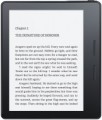Button control
The presence of a touch screen allows you to configure and control the device using the display. However, for greater convenience, in many e-readers, regardless of the type of screen, the
buttons still act as the main controls. Firstly, they can be pressed with gloves or wet hands. Secondly, holding a book with two hands is much easier to press the button to turn the page than to swipe your finger across the screen.
RAM
The amount of the reader's own RAM, that is, the memory used for temporary data storage during operation. The speed of the e-book directly depends on the amount of RAM, especially when working with large files. So the average value can be considered
RAM 1 GB and
2 GB, and more advanced models have
3 GB,
4 GB and even
6 GB of memory.
Multimedia
—
Headphone output(3.5 mm). A standard mini-jack connector that allows you to connect headphones to an audiobook. Most consumer-grade headphones currently being produced are equipped with a 3.5 mm plug, which makes this connector very versatile. Usually, the presence of a headphone output in an audiobook means that it is equipped with a built-in media player, and headphones can also be used to read text from the screen.
—
Dictaphone. The ability to use an e-book as a voice recorder, to record speech and other sounds. To do this, the device is equipped with its own built-in microphone, and to play the recorded material, an output to headphones and/or its own speaker is provided.
—
Built-in speaker. The audiobook has its own built-in speaker. The speaker can be used to play audio files, video soundtrack, or read text from the screen; the presence of a speaker, usually, implies the presence in the reader of at least one of the above functions.
—
Built-in dictionary. The presence in the software set of the book of an electronic dictionary (or several dictionaries), which allows the translation of individual words and expressions. This feature can be especially useful for those who like to read books in foreign languages.
— Built-in browser. The presence of a built-in browser allows you to view Internet
...pages on the screen of the reader; connection to the Internet is carried out using Wi-Fi.
— Built-in audio player. The ability to use an e-book to play audio files through headphones or a built-in speaker. The most common support for MP3 music files; some models are capable of playing other types of audio files, such as WMA, AAC, OGG, and even the lossless APE and FLAC formats.
— Voice reading. The ability of an e-book to read the written text and output it to external speakers or connected headphones. The voice sounds quite monotonous and with a noticeable "computer" accent. Pronunciation, usually, is at a level sufficient for understanding.
— Accelerometer. A device that reacts to shaking and changes in the position of an e-book in space. The accelerometer provides advanced control options: for example, you can change the screen orientation from portrait to landscape and vice versa by simply turning the reader to the appropriate position, switch the music track by shaking, etc.Case included
The presence
of a case in the delivery set of the electronic reader.
The case facilitates transportation of the device, protects its body from dirt and scratches, and to some extent protects from impacts and vibrations. The design of such an accessory can be different. One of the popular implementations is the "book" format (the case opens in the image and likeness of a book cover), cases exclusively for the back panel of the e-reader are also often found.

